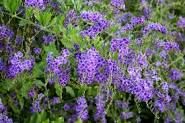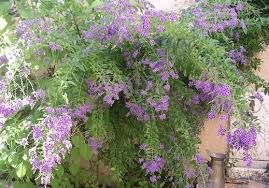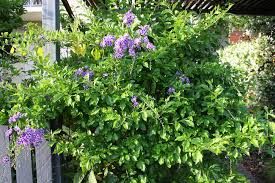BY BONNIE GARCIA
This unusual plant, the Duranta, is a Texas Superstar with beautiful blue-and-white orchid-like flowers. The shrub can reach 15 feet or more and be 2-4 feet wide. The species most cultivated is Duranta erecta, commonly called golden dewdrop. Variety ALBA produces white flowers but is not as well adapted as variety PLUMERI which produces lilac colored flowers.
The genus, Duranta, honors an Italian botanist and papal physician named Castore Durantes. Durantas are subtropical plants and are grown as perennial shrubs in the southern-most parts of America. They produce graceful, drooping branches, a few thorns, bright green leaves and numerous small blue, violet, or white flowers which bloom best in full sun throughout the year followed by golden fruits.
The variegated ones such as ’Gold Edge’ however, actually look best in partial shade.
Duranta does well in either acidic or alkaline soils and is somewhat resistant to disease and insect attack. It has medium salt tolerance and drought tolerance and low nutritional needs.
Here in the Valley, you may need to lower the pH by adding some peat moss. The shrub’s actual preference is for heavy soils.
Plant in the spring in rich, well-drained soil after all danger of frost has passed. When planting, choose a spot that gets between six to eight hours of sunlight per day and amend the soil with compost so that it is rich in nutrients and drains water well. Plant multiple Duranta at least 3 feet apart. When filling in the hole, water slightly and compress to remove the air pockets. Keep moist but do not over water. In addition, make sure the soil is in an area that drains well as Duranta do not like standing water.
A couple of inches of mulch, such as wood chips or bark will help retain water and help keep soil temperatures from fluctuating too much.
Keep the mulch at least an inch from the Duranta’s main stem because moisture can build up there and cause damage. Duranta attracts birds which feed on the fruits and has one of the few flowers that attract both hummingbirds and butterflies. It can be propagated by sowing the seed in the spring or from greenwood cuttings.
Warning: the berry is said to be toxic so keep away from pets and children.
Many Duranta attract bees, so plant them away from areas where people will be gathering.
bhg.com/gardening/plant-dictionary/annual/duranta
ehow.com/how_5132327_plant-duranta.html
floridata.com/ref/d/dura_ere.cfm
aggie-horticulture.tamu.edu/cemap/duranta/durantastory.html








